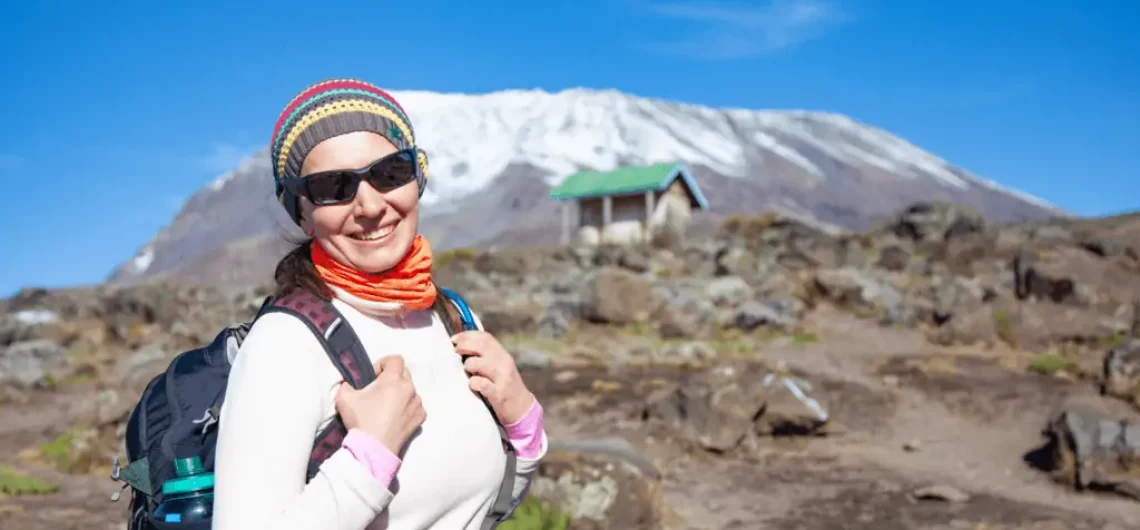Hiking Kilimanjaro alone as a woman is not possible because having a mountain guide and porters is compulsory; here, we are referring to solo climbers of less than two people or joining a group trek as a solo traveller. First off, happy International Women’s Day!
Embarking on a solo journey to summit Mount Kilimanjaro, the towering 19,341-foot icon of Tanzania, is a bold and exhilarating decision. For women, climbing Kilimanjaro alone—whether joining a group trek or opting for a private ascent—offers a unique blend of empowerment, introspection, and adventure. The mountain’s diverse landscapes, from lush rainforests to stark arctic summits, challenge your physical and mental resilience while rewarding you with unparalleled views and a profound sense of accomplishment. As a solo female trekker, you have the chance to craft an experience tailored to your pace, preferences, and personal goals, but it requires careful planning to ensure safety, comfort, and confidence.
Kilimanjaro’s allure lies in its accessibility to trekkers of varying experience levels, yet its high altitude, unpredictable weather, and multi-day demands make preparation critical. Women face distinct considerations, from managing personal hygiene in remote conditions to navigating cultural dynamics in Tanzania. Solo travel adds another layer, requiring you to balance independence with practical safety measures. Whether you’re an experienced hiker comfortable with solitude or a first-time adventurer easing into solo trekking, this journey demands respect for the mountain’s challenges and your own capabilities.
This guide is designed specifically for women hiking Kilimanjaro alone, offering practical and empowering tips to address unique needs. From choosing a route that matches your skills to mastering bathroom logistics in freezing conditions, handling menstruation at altitude, packing smart, ensuring personal safety, and preparing for Tanzania’s cultural context, these strategies will help you tackle the mountain with confidence. The goal is to equip you with the knowledge and tools to embrace this solo adventure fully, turning potential challenges into opportunities for growth and triumph. Let’s explore how to make your Kilimanjaro climb a safe, rewarding, and unforgettable experience.
1. Choose a Route That Matches Your Skills and Comfort Level
Selecting the right Kilimanjaro route is the foundation of a successful solo trek, especially as a woman hiking alone. Kilimanjaro offers several routes—Marangu, Machame, Lemosho, Rongai, Umbwe, and Northern Circuit—each varying in difficulty, duration, terrain, and scenery. As a solo female trekker, prioritize a route that aligns with your hiking experience, fitness level, and comfort with isolation or crowds.
- Beginner-Friendly Routes: If you’re new to high-altitude trekking or solo hiking, consider the Marangu Route (5-6 days), known as the “Coca-Cola Route” for its hut accommodations and gentler gradients. It’s more developed and often busier, offering a sense of security for solo travellers. The Rongai Route (6-7 days) is another good option, with a quieter trail and gradual ascent, ideal if you prefer less crowded paths but still want a manageable challenge.
- Intermediate to Advanced Routes: For experienced hikers, the Machame Route (6-7 days) or Lemosho Route (7-8 days) offer stunning scenery and more rugged terrain. These routes are popular, so you’re likely to encounter other trekkers, but they require stronger fitness and comfort with camping. The Northern Circuit (8-9 days) is the longest and least crowded, perfect if you’re highly experienced and crave solitude, but it demands greater endurance.
- Safety Tip: Avoid the Umbwe Route unless you’re an expert hiker, as its steep, technical terrain can be intimidating for solo trekkers. If you’re nervous about hiking alone, opt for a popular route with more trekkers or a shorter trek to build confidence. Familiarize yourself with the route’s daily itinerary and terrain through guidebooks or operator briefings to know what to expect.
Joining a group trek as a solo traveller is often the safest and most social option, allowing you to connect with others while maintaining independence. If you prefer a private climb, ensure your operator provides a trusted guide and sufficient support staff.
2. Master Bathroom Logistics with Confidence
Managing bathroom breaks on Kilimanjaro can feel daunting, especially in freezing temperatures or mixed-gender groups. As a solo female trekker, you’ll need strategies to handle urination, hygiene, and privacy discreetly and efficiently.
- Female Urination Devices (FUDs): A female urination device, often called a “she-wee,” is a game-changer for peeing on the trail without squatting. These funnel-shaped tools allow you to urinate standing up, minimizing exposure to cold, wind, or prying eyes. Choose a lightweight, collapsible, and leak-proof model designed for trekking. Practice using it at home (in the shower is ideal) to master the technique before your trip. Brands like GoGirl or Shewee are popular choices.
- Hygiene on the Trail: Multi-day treks increase the risk of urinary tract infections (UTIs) or yeast infections, so hygiene is critical. Pack biodegradable toilet paper or a reusable cloth (like a Kula Cloth) and seal used items in a small, odor-proof dry bag for responsible disposal off the mountain. Carry ample hand sanitizer and use it before and after bathroom breaks. Wet wipes (biodegradable only) are useful for freshening up, but pack them out per Leave No Trace principles.
- Strategic Positioning: Choose bathroom spots carefully to avoid wind, slopes, or water sources like streams, which could contaminate drinking water. On busy routes, step off the trail for privacy, using rocks or bushes for cover. At camp, use the provided toilet tents, which offer more privacy than open trail stops.
- Nighttime Tips: Summit night, with temperatures as low as 0°F, makes bathroom breaks especially tough. Keep your FUD and hand sanitizer in your sleeping bag to avoid fumbling in the cold. If using a toilet tent at night, bring a headlamp and ask a guide to accompany you to the tent for safety.
Pee Bottles and Shee wees: A Guide to Using Them on Kilimanjaro
3. Prepare for Menstruation at Altitude
Getting your period on Kilimanjaro is a common concern, as altitude, stress, and travel can disrupt your cycle, causing it to arrive unexpectedly. Planning ahead ensures you’re ready to manage menstruation comfortably and hygienically.
- Supplies to Pack: Bring enough menstrual products for the entire trek, even if you don’t expect your period. Menstrual cups are highly recommended for their eco-friendliness and convenience, as they reduce waste and don’t require packing out used products. If you prefer pads or tampons, store used items in a reusable, odour-proof dry bag (plastic bags are banned in Tanzania). Panty liners are great for lighter days or as a backup.
- Hygiene Essentials: Pack biodegradable wet wipes and extra hand sanitiser for cleanliness, as water for washing is limited. Black or dark-colored leggings or hiking pants can conceal potential stains, boosting confidence. A small mirror can help with menstrual cup adjustments in private.
- Health Considerations: Altitude and dehydration can exacerbate cramps or fatigue, so stay hydrated (aim for 3-4 litres of water daily). Consult your doctor about taking ibuprofen or other pain relievers at altitude, especially if you’re using Diamox for altitude sickness prevention. If you use birth control to skip periods, confirm with your doctor that it’s safe at high altitudes, as hormonal changes can be unpredictable.
- Sharing Supplies: Solo trekkers often join mixed groups, so packing extra supplies to share with other women fosters camaraderie and preparedness. A small ziplock with tampons, pads, or liners can be a lifesaver for a fellow trekker caught off guard.
Menstrual Period on your Kilimanjaro trek? No problem.
4. Pack Smart for Comfort and Practicality
Packing for Kilimanjaro requires balancing weight, functionality, and women-specific needs. As a solo trekker, you’ll rely on your gear to keep you comfortable and confident, so choose items tailored to the mountain’s diverse conditions.
- Underwear and Sports Bras: Pack 4-6 pairs of moisture-wicking, quick-drying underwear (avoid cotton, which traps moisture). Merino wool or synthetic blends are ideal for odour resistance and comfort. Bring 2-3 supportive sports bras designed for high-impact activities, also in non-cotton materials. Test them on training hikes to ensure they don’t chafe.
Important Kilimanjaro inner wear, shorts and underwears - Layering for Versatility: Kilimanjaro’s five climate zones demand a layering system. Pack convertible hiking pants (zip-off to shorts), waterproof rain pants, fleece pants for summit night, and long underwear for warmth. Dark-colored bottoms are practical for concealing stains. A lightweight, packable skirt can add modesty at camps or in towns like Moshi.
- Personal Care: Water is scarce on the trail, so swap beauty routines for trekking-friendly alternatives. Pack SPF lip balm, moisturising sunscreen (SPF 50+), and dry shampoo to refresh hair. A small microfiber towel is useful for spot-cleaning. If you wear contacts, bring extra solution and glasses as backup, as dust and cold can irritate your eyes.
- Packing Tip: Use a 50- 65l backpack and keep your total weight under 15kg (33 lbs), as porters carry most gear, but you’ll carry a daypack (20- 30l). Organise items in dry bags to protect against rain and make essentials like your FUD or menstrual supplies easily accessible.
Best Sport Bras for hiking Kilimanjaro
5. Prioritise Safety as a Solo Female Trekker
Safety is a top concern for women hiking Kilimanjaro alone, but with the right precautions, you can climb confidently. Whether joining a group or trekking privately, these tips ensure a secure experience.
- Choose a Reputable Operator: Research operators with strong safety records and female-friendly policies. Look for companies that employ female guides or porters, support solo travelers, and have clear protocols for addressing harassment or discomfort. Ask to connect with past solo female clients for insights.
- Group vs. Private Treks: Joining a group trek is ideal for solo travelers, offering companionship and added safety. Request to share a tent or hotel room with another female trekker or pay a single supplement for privacy. For private climbs, ensure your guide is vetted and communicate your preferences upfront.
Join a group Kilimanjaro climb 2025-2026 Dates & Prices - Cultural Awareness: Tanzania is generally welcoming, but dress modestly in towns like Moshi or Arusha (cover shoulders and knees). Avoid walking alone at night and travel with a companion during the day for added security. On the trail, cultural differences may arise with male guides or porters; address any discomfort promptly with your guide or operator.
- Emergency Preparedness: Carry a whistle, personal locator beacon (PLB), or satellite communicator for emergencies, as cell service is unreliable. Share your itinerary with family or friends and check in post-trek. Inform your guide of any medical conditions or concerns privately before the climb.
- Weather Awareness: Check weather forecasts before starting, as rain, snow, or ice can make trails slippery or dangerous. Pack appropriate layers (e.g., waterproof jacket, warm hat) and be prepared to turn back if conditions worsen, especially on summit night.
6. Build Confidence Through Preparation
Confidence is key to enjoying your solo Kilimanjaro trek. Physical and mental preparation will help you feel empowered and ready for the challenge.
- Training: Train for 3-6 months with cardio (running, cycling), strength exercises (squats, lunges), and long hikes with a weighted pack. Practice hiking in varied weather to simulate Kilimanjaro’s conditions. If possible, train at higher altitudes to acclimate.
- Mental Resilience: Solo trekking can feel isolating, especially during tough moments like summit night. Practice mindfulness or visualization to stay focused. Connect with other solo female trekkers online for tips and encouragement.
- Test Gear: Break in your hiking boots and test all gear (FUD, menstrual products, clothing) on training hikes to avoid surprises. Familiarize yourself with your backpack’s organization to access items quickly on the trail.
![]()


Comments